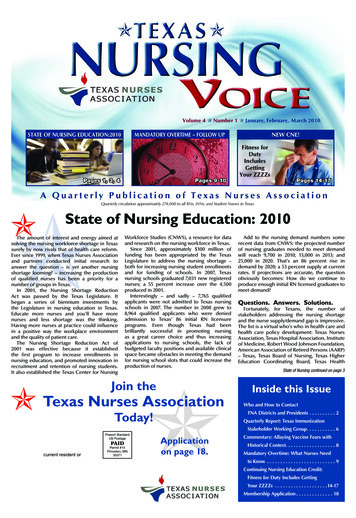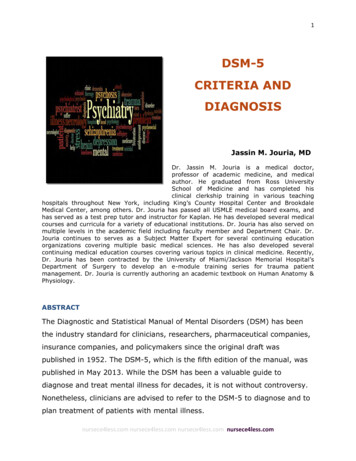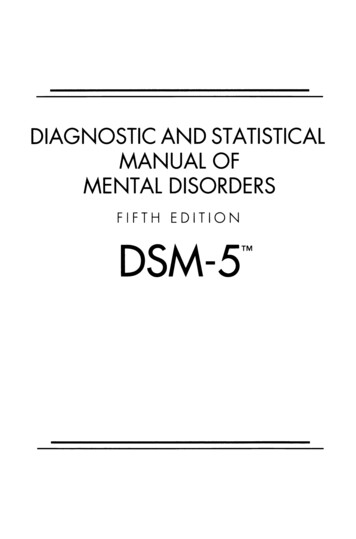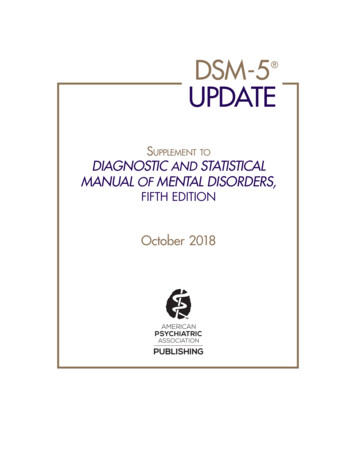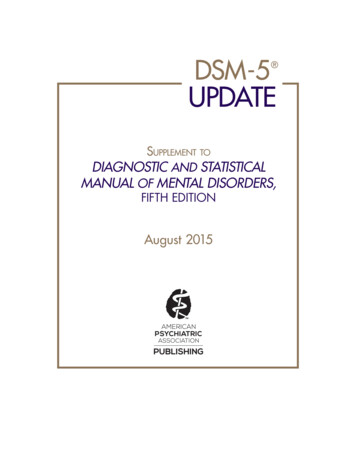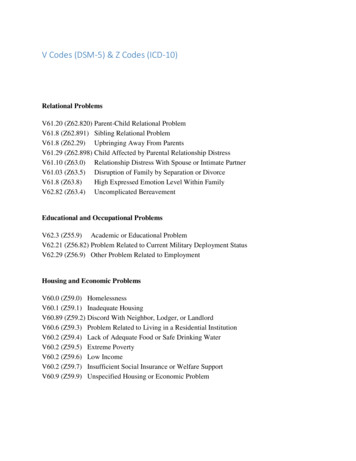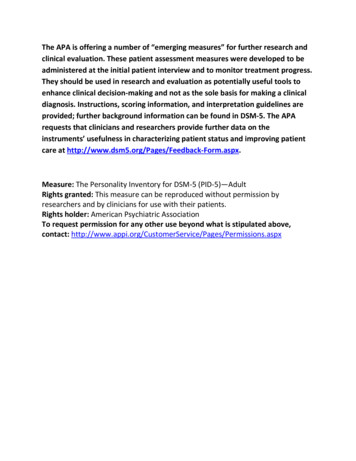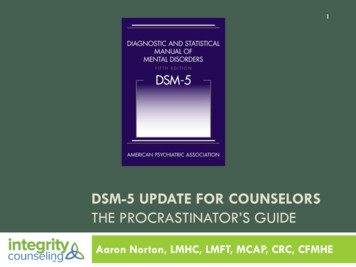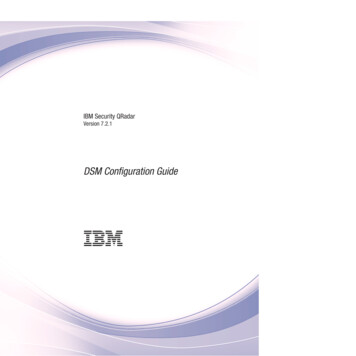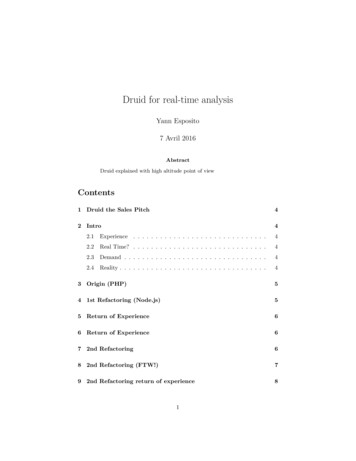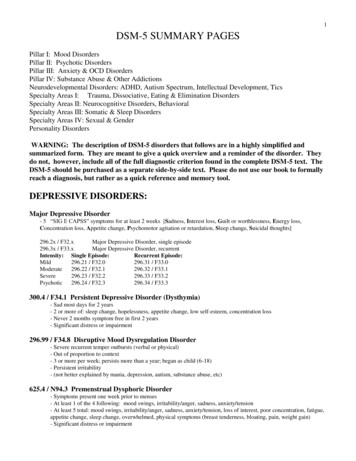
Transcription
1DSM-5 SUMMARY PAGESPillar I: Mood DisordersPillar II: Psychotic DisordersPillar III: Anxiety & OCD DisordersPillar IV: Substance Abuse & Other AddictionsNeurodevelopmental Disorders: ADHD, Autism Spectrum, Intellectual Development, TicsSpecialty Areas I: Trauma, Dissociative, Eating & Elimination DisordersSpecialty Areas II: Neurocognitive Disorders, BehavioralSpecialty Areas III: Somatic & Sleep DisordersSpecialty Areas IV: Sexual & GenderPersonality DisordersWARNING: The description of DSM-5 disorders that follows are in a highly simplified andsummarized form. They are meant to give a quick overview and a reminder of the disorder. Theydo not, however, include all of the full diagnostic criterion found in the complete DSM-5 text. TheDSM-5 should be purchased as a separate side-by-side text. Please do not use our book to formallyreach a diagnosis, but rather as a quick reference and memory tool.DEPRESSIVE DISORDERS:Major Depressive Disorder- 5 “SIG E CAPSS” symptoms for at least 2 weeks [Sadness, Interest loss, Guilt or worthlessness, Energy loss,Concentration loss, Appetite change, Psychomotor agitation or retardation, Sleep change, Suicidal thoughts]296.2x / F32.xMajor Depressive Disorder, single episode296.3x / F33.xMajor Depressive Disorder, recurrentIntensity: Single Episode:Recurrent Episode:Mild296.21 / F32.0296.31 / F33.0Moderate296.22 / F32.1296.32 / F33.1Severe296.23 / F32.2296.33 / F33.2Psychotic296.24 / F32.3296.34 / F33.3300.4 / F34.1 Persistent Depressive Disorder (Dysthymia)- Sad most days for 2 years- 2 or more of: sleep change, hopelessness, appetite change, low self-esteem, concentration loss- Never 2 months symptom free in first 2 years- Significant distress or impairment296.99 / F34.8 Disruptive Mood Dysregulation Disorder- Severe recurrent temper outbursts (verbal or physical)- Out of proportion to context- 3 or more per week; persists more than a year; began as child (6-18)- Persistent irritability- (not better explained by mania, depression, autism, substance abuse, etc)625.4 / N94.3 Premenstrual Dysphoric Disorder- Symptoms present one week prior to menses- At least 1 of the 4 following: mood swings, irritability/anger, sadness, anxiety/tension- At least 5 total: mood swings, irritability/anger, sadness, anxiety/tension, loss of interest, poor concentration, fatigue,appetite change, sleep change, overwhelmed, physical symptoms (breast tenderness, bloating, pain, weight gain)- Significant distress or impairment
2BIPOLAR DISORDERS:296.7 / F31.9 Bipolar I Disorder- Euphoric or irritable mood and increased energy or activity for 1 week- 3 out of 7: grandiose, decreased sleep, talkative, racing thoughts, distractibility, increased goal-directed activity,impulsive)- Social or work impairment296.89 / F31.81 Bipolar II Disorder- At least 1 Hypomanic episode and at least 1 Major Depressive episode- No full Manic episodesHypomanic Episode:- Same as Bipolar I Manic episode except: at least 4 days duration (instead of 7)- And NO marked impairment in social or occupational functioning301.13 / F34.0 Cyclothymic Disorder- Numerous hypomania and depression symptoms for most of the time for 2 years- Never reaches full diagnosis for either hypomanic, manic or depressive episodes- Not without symptoms for 2 months in 1st 2 years.- Clinically significant distress or impairmentMay Add Specifiers:with Anxious Distresswith Mixed Features (mania and depression)with Rapid Cycling (for Bipolar I and II: 4 episodes per year)with Melancholic Features (loss of pleasure, lack of reactivity, despair, worse in a.m., early morning awakening)with Atypical Features (weight gain, increased sleep, leaden paralysis, interpersonal rejection sensitivity, mood reactivity)with Psychotic Features, with Catatonia, with Peripartum Onset, with Seasonal PatternPSYCHOTIC DISORDERS:295.90 / F20.9 Schizophrenia- Must have 1 positive symptom (hallucinations, delusions or disorganized speech) for 1 month- 2 of the following: hallucinations, delusions, disorganized speech, disorganized behavior, or negative symptoms(low emotion, low motivation)- Prior or residual poor functioning for at least 6 months- Social or work impairment295.40 / F20.81 Schizophreniform Disorder- Schizophrenic symptoms between 1-6 months duration295.70 / F25.0 Schizoaffective Disorder, Bipolar type- Schizophrenic symptoms and Bipolar I symptoms present most of the time.- At least 2 weeks of delusions or hallucinations without Bipolar symptoms- Must have Bipolar symptoms for the majority of time.295.70 / F25.1 Schizoaffective Disorder, Depressive type- Schizophrenic symptoms and Depression symptoms present most of the time.- At least 2 weeks of delusions or hallucinations without Depression symptoms- Must have Depression symptoms for the majority of time.
3297.1 / F22 Delusional Disorder- Moderate delusions at least 1 month, not Schizophrenic level- Otherwise good functioning; no bizarre behavior- Erotomanic type- Grandiose type- Jealous type- Persecutory type- Somatic type- Mixed type- Unspecified type298.8 / F23 Brief Psychotic Disorder- Schizophrenic symptoms for less than 1 month- Full return to premorbid level.- with marked stressors- without marked stressors- with postpartum onset- with CatatoniaANXIETY DISORDERS:300.01 / F41.0 Panic Disorder- Recurrent, abrupt, unexpected intense fear or discomfort- Persistent worry of additional attacks for 1 month- 4 out of 13 symptoms: (palpitations, sweating, trembling, shortness of breath, choking, chest pain, nausea, dizziness,derealization, fear of “going crazy”, fear of dying, numbness/tingling, hot/cold flashes)- "Panic Attack" can also be a specifier for other diagnoses (i.e. "PTSD with Panic Attacks")300.22 / F40.00 Agoraphobia- Intense fear of 2 or more of: public transportation, open spaces (markets, bridges), enclosed spaced (theaters, shops),crowds, being away from home.- Avoids these areas- Greater than 6 months; interferes with work or social functioning300.02 / F41.1 Generalized Anxiety Disorder- Excessive worry most days for 6 months- 3 out of 6: (restless, fatigue, concentration, irritability, tense, insomnia)- Interferes with work / social functioning300.29 Specific Phobia- Intense unreasonable fear- Interferes with work / social functioningF40.218 - Animal fear (insects, snakes, dogs, etc)F40.228 - Natural environment (heights, thunderstorms, etc)F40.231 - Needle injectionsF40.248 - Situational (elevators, planes, tight spaces)F40.298 - Other300.23 / F40.10 Social Anxiety Disorder- Formerly "Social Phobia"- Persistent fear of social interaction or performance- Interferes with work / social functioning309.21 / F93.0 Separation Anxiety Disorder
4- Excessive anxiety over separation from home or parents313.23 / F94.0 Selective Mutism- Mute in some settings but not othersOBSESSIVE-COMPULSIVE DISORDERS:300.3 / F42 Obsessive-Compulsive Disorder- Obsessions: persistent intrusive, inappropriate non-psychotic thoughts- Compulsions: repetitive behaviors compelled to reduce distress- Patient sees as excessive / unreasonable- Marked distress / interference300.7 / F45.22 Body Dysmorphic Disorder- Preoccupation with imagined defect in physical appearance- Repetitive checking, grooming, picking, comparing, or reassurance seeking- Work / social impairment312.39 / F63.2 Trichotillomania- Recurrent hair pulling and hair loss- Failed attempts to stop hair pulling- Marked distress or impairment300.3 / F42 Hoarding Disorder- Can’t discard possessions regardless of value- Possessions accumulate, cluttering living space- Marked distress or impairment698.4 / L98.1 Excoriation (Skin-Picking) Disorder- Persistent skin picking causing lesions or infections- Failed attempts to stop skin picking- Marked distress or impairmentSUBSTANCE ABUSE DISORDERS:Alcohol Use Disorder305.00 / F10.10 MILD 2-3 symptoms303.90 / F10.20 MOD 4-5 symptoms303.90 / F10.20 SEV 6 or more symptomsSymptom List:- Uses more than intended- Failed attempts to cut back- Excessive time spent in obtaining, using, or recovering from substance- Cravings for substance- Substance use leads to problems at work, school or home- Important work, social or recreational activities are given up due to substance use- Uses in dangerous situations- Persistent use despite awareness of problem- Tolerance (needs more substance for same effect)- Withdrawals
5Alcohol Use, Intoxication, or Withdrawal DisordersCaffeine Intoxication or Withdrawal DisordersCannabis Use, Intoxication, or Withdrawal DisordersHallucinogen Use or Intoxication DisordersInhalant Use or Intoxication DisordersOpioid Use, Intoxication, or Withdrawal DisordersSedative Use, Intoxication, or Withdrawal DisordersStimulant (Cocaine / Amphetamine) Use, Intoxication, or Withdrawal DisordersTobacco Use or Withdrawal Disorders312.31 / F63.0 Gambling Disorder- Continued gambling despite distress or impairment- 4 of the following: increasing amounts of money gambled, irritable when cuts back on gambling, failed attempts tocut back, preoccupied with gambling, gambles to feel better, "chases their losses" (gambles later to make their moneyback), lies about gambling, relationship / work / or school problems, others give them money to help desperate needcaused by losses.NEURODEVELOPMENTAL DISORDERS:Attention-Deficit / Hyperactivity Disorder (ADHD)- Persistent inattention or hyperactivity interfering with functioning for 6 months, began before age of 12- Inattention- 6 or more of the following: inattention to details, difficulty sustaining attention, doesn't listen well, poorfollow through on tasks, poor organization, avoids homework or large projects, often loses things, distractible,forgetful- Hyperactivity - 6 or more of the following: fidgets or squirms, leaves seat often, runs around inappropriately, can'tplay quietly, driven, always moving, overly talkative, blurts out answers, difficulty waiting or taking turns, interruptsfrequently314.01 / F90.2 ADHD, Combined314.00 / F90.0 ADHD, Inattentive314.01 / F90.1 ADHD, Hyperactive / Impulsive299.00 / F84.0 Autism Spectrum Disorder:Problems with social communication and social interactionRepetitive behaviors; 2 of the following:- Repetitive actions or speech- Insistence on sameness- Restricted fixated interests- Increased or decreased sensitivity to sensory stimulation3 Levels:Level 1 - requiring supportLevel 2 - requiring substantial supportLevel 3 - requiring very substantial supportCommunication Disorders:315.39 / F80.9 Language Disorder - difficulty using language315.39 / F80.0 Speech Sound Disorder - difficulty speaking315.35 / F80.81 Childhood Onset Fluency Disorder - stuttering issues315.39 / F80.89 Social (Pragmatic) Communication Disorder - speaking difficulties in social contextSpecific Learning Disorders:315.00 / F81.0 Learning Disorder in Reading315.2 / F81.81 Learning Disorder in Writing
6315.1 / F81.2 Learning Disorder in Mathematics319 Intellectual Disability [ F70 - Mild; F71 - Moderate; F72 - Severe; F73 - Profound]- Decreased intellectual functioning- Decreased developmental and social functioning- Begins in childhoodMotor Disorders:315.4 / F82 Developmental Coordination Disorder- Coordination impairment, clumsy, slow, inaccurate- Marked distress / interference307.3 / F98.4 Stereotypic movement Disorder- Repetitive purposeless movement (head banging, rocking, biting, picking, hitting, etc.)- Interferes with functioning or self-injurious307.23 / F95.2 Tourette’s Disorder- Multiple motor tics 1 vocal tic- Persistent for 1 year- Marked distress or impairment- Onset before 18 years old307.22 / F95.1 Persistent Motor or Vocal Tic Disorder- Motor only or vocal only tics- Persistent for 1 year- Marked distress or impairment- Onset before 18 years old307.21 / F95.0 Provisional Tic Disorder- Tics, 4 weeks to 1 year- Marked distress or impairment- Onset before 18 years oldTRAUMA & STRESS DISORDERS:309.81 / F43.10 Post Traumatic Stress Disorder (PTSD)- Severe Trauma - experienced trauma, witnessed trauma, or learned about violent trauma to loved one- Intrusive memories, nightmares, flashbacks- Avoidance - (avoid memories, thoughts, feelings, reminders)- Negative thoughts & feelings: amnesia to the event, exaggerated negative beliefs, self (or other) blame, persistentfear / anger / horror / shame, low interest in activities, feeling detached, feeling numb- Hyperarousal (insomnia, poor concentration, emotional lability, hypervigilance, exaggerated startle, reckless or selfdestructive behavior)- Symptoms present for 1 month and work / social impairmentPreschool Subtype (under 6 years of age)308.3 / F43.0 Acute Stress Disorder- PTSD, but less than one month since trauma.Adjustment Disorders- Stressor leading to excessive distress or work / social impairment- Symptoms do not last greater than 6 months after resolution of stress- Specify stress as acute or chronic (greater than 6 months)
7309.0 / F43.21 Adjustment Disorders with depressed mood309.24 / F43.22 Adjustment Disorders with anxiety309.28 / F43.23 Adjustment Disorders with mixed anxiety and depressed mood309.3 / F43.24 Adjustment Disorders with disturbance of conduct309.4 / F43.25 Adjustment Disorders with mixed disturbance of emotions and conduct313.89 / F94.1 Reactive Attachment Disorder- Poor care-giving at early age (neglected, deprived, too numerous care-givers, or orphanage)- Emotionally withdrawn behavior towards care-givers (doesn't seek or respond to comfort)- Socially and emotionally unresponsive, inappropriately irritable /sad / or fearful313.89 / F94.2 Disinhibited Social Engagement Disorder- Poor care-giving at early age (neglected, deprived, too numerous care-givers, or orphanage)- Child inappropriately approaches or is overly familiar with unknown adult.DISSOCIATIVE DISORDERS:300.14 / F44.81 Dissociative Identity Disorder (Multiple Personality)- 2 or more distinct personalities recurrently take control- Compartmentalization of information.- Marked distress or impairment300.12 / F44.0 Dissoc
DSM-5 should be purchased as a separate side-by-side text. Please do not use our book to formally reach a diagnosis, but rather as a quick reference and memory tool. DEPRESSIVE DISORDERS: Major Depressive Disorder - 5 “SIG E CAPSS” symptoms for at least 2 weeks [Sadness, Interest loss, Guilt or worthlessness, Energy loss, C .
